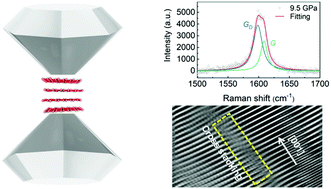sp2-to-sp3 transitions in graphite during cold-compression†
Abstract
Pressure-induced sp2-to-sp3 transitions in graphite have been studied for decades by experiments and simulations. In general, pressures of 15–18 GPa are needed to initiate structural transitions in graphite at room temperature, and the high-pressure phases are usually unquenchable, as evidenced by in situ resistivity and optical transmittance measurements, X-ray diffraction (XRD), and inelastic X-ray scattering (IXS). However, our in situ Raman results show that the onset transition pressure can be as low as 9.7 GPa when using the methanol–ethanol–water (MEW) mixture as the pressure-transmitting medium (PTM), indicated by an additional GD Raman peak caused by the sp3 bonding between adjacent graphite layers. Moreover, using a combination of XRD, Raman, X-ray photoelectron spectroscopy (XPS), and high-resolution transmission electron microscopy (HRTEM), we show that a small amount of sp3 bonds associated with a unique feature of cross stacking are present in the recovered samples. Our findings will be useful to understand the intricate structural transitions in graphite-like materials under compression.



 Please wait while we load your content...
Please wait while we load your content...